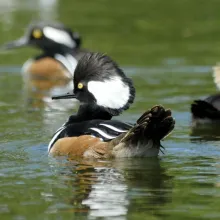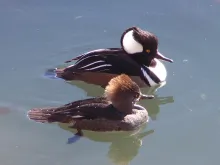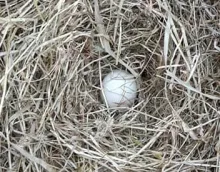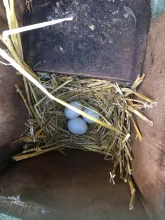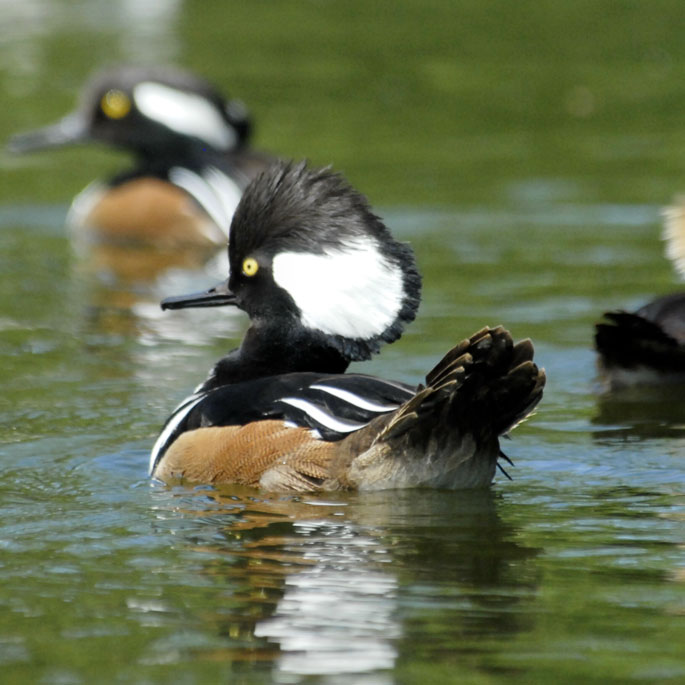
Hooded merganser (Lophodytes cucullatus)
Species name
- Dutch name:
- Kuifzaagbek of Kokardezaagbek
- English name:
- Hooded merganser
- German name:
- Kappensäger
- French name:
- Harle couronné
- Scientific name:
- Lophodytes cucullatus
Scientific classification
- Order:
- Anseriformes
- Family:
- Anatidae
- Onderfamilie:
- Merginae
- Genus:
- Lophodytes
Description
- Description:
Male:
hooded mergansers have a large white crest surrounded by black. The top of the head, neck and back are all black, and the chest, breast and belly are white. Wavy black lines can be seen on the tawny sides and flanks. The hind back, rump and tail are dark brown. The long, narrow, serrated bill is black. The iris is bright yellow and the legs and feet are dull yellow.Female:
have a gray-brown head and neck with a reddish-brown crest. Gray pervades their neck, chest, sides and flanks, and brownish-black dominates their back, rump and tail. The upper bill is black-edged with orange and the lower bill is yellow. The legs and feet are greenish in color and the iris is brown.Juvenile:
Juvenile Females: have a gray-brown head and neck with. Gray pervades their neck, chest, sides and flanks, and brownish-black dominates their back, rump and tail. The upper bill is black-edged with orange and the lower bill is yellow. The legs and feet are greenish in color and the iris is brown. Looks like adult Female.Juvenile Males:
Takes two years for them to get prime adult breeding plumage until then they appear as females with slight appearances and have a gray-brown head and neck with a few black feathers and white feathers threw out head and neck. Gray pervades their neck, chest, sides and flanks, and brownish-black dominates their back, rump and tail. The upper bill is black-edged with orange and the lower bill is yellow. The legs and feet are greenish in color and the iris is brownish Turning Yellow.
- Behaviour:
Hooded Mergansers are clumsy, but quick, flyers. They take off by running on water, and they have a ceaseless and rapid wingbeat during flight. They land at high speeds and are often seen ‘skiing’ across the water to come to a stop. They dive well, holding their wings in close to their body and propelling themselves underwater with their feet.
Standard Measurements
- Body Length (cm):
- The male (drake) of the Hooded merganser measures approximately 43-47 centimeters. The female measures approximately 43-47 centimeters.
- Body Weight (grams):
- The male will weight about 650 gram. The female will weight about 550 gram.
The weight is notoriously variable and can only be used as indication!
- Note:
Hooded mergansers require a large area of deep (at least 80cm), clear water, with ice-free water maintained in winter. They can be kept in mixed collections but may bully smaller weaker species while nesting.
Established pairs of these ducks usually breed. Infertility may be a problem, possibly due to males entering, and leaving, breeding condition earlier than females. Several pairs may be maintained in one enclosure, and if maintained in a group collective courting by drakes may be seen. A choice of several raised nest boxes should be provided for nesting, on posts over water, or on the banks, facing the pond and with ramps, 10cm wide, at an angle of 45 degrees, to just below the nest box entrance hole. Box size of 35cm by 30cm by 30cm suggested, with a circular entrance hole, 8cm diameter, close to the top of the box, and soil (5cm deep), peat (2.5cm deep) and a handful of dry grass in the bottom. An alternative design is to use a hollow log, 60-90cm high, provided with a roof and a ramp leading to a 7.5cm entrance hole close to the top; this may be set on a pole for greater height.
These ducks may also lay in boxes used by other species. Eggs are laid mainly April to May, and a second clutch may be laid if the first clutch of eggs is removed. Eggs may be incubated by mallards.
Ducklings are not considered easy to rear; there may be some difficulty in persuading incubator-hatched hand-reared ducklings to feed - livefood such as mealworms are useful to encourage feeding initially. A solitary duckling is unlikely to do well and should be placed with other, similar-sized ducklings.
N.B. ducklings are very agile and are good climbers; rearing boxes should be covered with wire tops.
May hybridise with other mergansers and other Anatidae: hybrids reported with Redhead - Aythya americana, Common goldeneye - Bucephala clangula, Common merganser - Mergus merganser, Red-breasted merganser - Mergus serrator, Wood Duck (Aix Sponsa).
- Breeding:
- The female Hooded merganser usually lays from 7-15 Shiny white eggs and incubates them for 28-30 days.
- Artificial incubating:
The ideal relative humidity for incubating most waterfowl eggs is 55% (ground nesters) and 40% (cavity nesters). The temperature is usually 37.4°C. Set ventilation as recommended by the incubator manufacturer. Eggs must be turned, either automatically or by hand, a minimum of 4 times a day. As the duckling develops there is a loss of water from the egg and the air sac gets bigger. In normal development of an egg with a 28-30 days incubation, the air sac occupies about a third of it three days earlier. Cleanliness is vital and ideally eggs should be moved to a separate hatcher at this point, where the humidity should be increased to 65% and even higher once they have pipped internally.
- Bird banding:
- Recommended closed leg band ring size for the Hooded merganser is 9 mm.The leg band ring can only be applied on a young small duck at around 11 days old.
- It doesn't matter what leg that you band, but it's good to have a consistent system. Suggested: Left leg = Female, Right leg = Male
- Maintenance food:
-


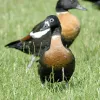


Floating full food for all sea ducks, green ducks, eider ducks and geese, especially in the moulting and breeding phase ideally suited. Packed with wholesome raw materials, natural vitamins and trace elements, this performance food with a protein content of 30% forms the basis for lifelong vitality.
